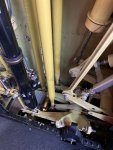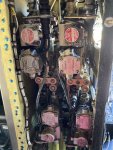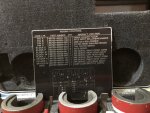Cyclic, aka stick (center of pic) used for forward, backward and sideways flight, yaw pedals (foreground of pic), below the dash, used to point the nose left or right and the thrust (lower left) used for up/down, receive manual input which is transferred to the flt closet ,

where metal tubes (horizontal and vertical yellow and 1 black) with adjustable rod ends (kinda like tierod ends in the steering at the axle) meet the bellcranks (yellow thing at the bottom of the pic where the 3 ylw and 1 bl

In addition to the bellcranks mid pic with holes showing, where the pallet rig pins go through, as is the lower closet bellcranks pic below

From there, manual input has been converted to mechanical leverage/input, goes up to a 2 section hyc actuator ( back side of 2 of the 4 dual section actuator pic below) turn mech input to hyd input at the bottom, converting back to mech out/input at the top. The actuator allow the pilots to manipulate 6 375# blade, spinning 224 rpms, causing directional flight

After the above pic actuators, input is sent to the 1st and 2nd mixing, where they take 4 different axis inputs, mix them into 2 outputs, for the fwd, tunnel and aft pylon mech controls, that are connected to hyd actuators in the fwd pylon and 2 in the aft pylon, that is connected to the swashplate, which again turns hyd output back to mech input to, what looks like 3 long turnbuckles, or pc (pitch change) links that are connected to the spinning head, where the rotor blades are attached, and push/pull on a certain part of the head, causing a vertical twisting action that lifts or lowers the front of the blade, diverting airflow (like sticking your hand out the car window horizontally, while driving 60 mph, are twisting you arm causing you hand to dip or raise, which causes your arm to to follow suit).
At every connection point along the way, from cockpit to pc links, there is an adjustment that is set to X to X measurement bring the controls to a predetermined “neutral” position, providing X distance of travel.








